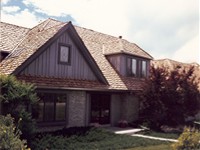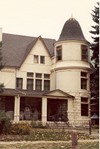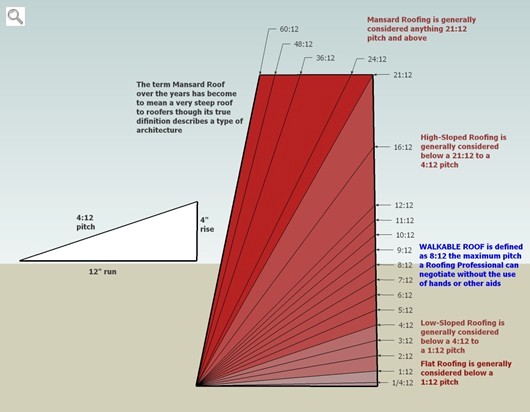Types of Roofing
Roof Slopes define what Types of Roofing Materials can be used and where. All roofing materials are grouped into one of two main groups or Types of Roofing defined by the pitch or slope of the roof: Steep-Sloped Roofing and Low Sloped Roofing.
The use of only Low-Sloped Roofing can be confusing because the term Low-Sloped Roofing can mean additional installation procedures and materials are needed when installing Steep-Sloped Roofing materials on roofs with lower pitches and it also means basically, the roofing of Flat Roof areas.
For clarity we use the words Steep-Sloped Roofing and Low-Sloped/Flat Roofing to describe the Types of Roofing Materials to be used. Roofing materials are designed for one or the other.
To further confuse things, Steep-Sloped Roofing sometimes is referred to as Residential Roofing where Low-Sloped/Flat Roofing is expressed as Commercial Roofing. But Steep-Sloped as well as Low-Sloped/Flat Roofing materials are installed on both Residential and Commercial roofs.
Residential actually describes types of structures such as single family homes, townhomes, duplexes, etc. as constructed using the International Residential Code (IRC). Commercial describes types of structures such as apartment buildings, condos, office buildings, warehouses, shopping malls, etc. as constructed using the International Building Code (IBC).
The term Steep-Sloped Roofing Materials generally means roofing materials that are designed to shed water rapidly with no standing water and are individually fastened to a Steep-Sloped Roof with fasteners. A Contractor who describes himself as a Residential Roofing Company means he installs roofs mainly on residential structures and specializes in the installation of roofing materials designed for Steep-Sloped Roofing.
The term Low-Sloped/Flat Roofing Materials generally means roofing materials that are designed to withstand the slow drainage of water without developing leaks. Commercial roofing products are generally rolled roofing membranes or sheets that are adhered to a roof by means of tar, asphalt, glue, heat welded, etc. and have seams that are also completely sealed together. A Contractor who describes himself as a Commercial Roofing Company means he installs roofs mainly on commercial structures and specializes in the installation of roofing materials designed for Low-Sloped/Flat Roofing.
As you can see, this all can be confusing to both consumers and roofers alike. Below we try to clarify and define some roofing terms used when trying to describe types of roofing and/or roofing materials.
There are three different types of roofing within Steep-Sloped Roofing: Low-Sloped Roofing, High-Sloped Roofing and Mansard Roofing.
The terms Steep-Sloped Roofing and Low-Sloped/Flat Roofing are defined by the pitch/slope of the roof and the type of materials that are commonly used for that pitch range. The slope or pitch of a roof is defined as the ratio of the rise to the run of the rafters. For an example a 4" rise in a 12" run is expressed as 4:12. (Click on the sketch below to go to a larger sized sketch.)
(1) Low-Sloped/Flat Roofing generally refers to roofs with slopes less than 1:12. However many, including myself, consider anything under a 2:12 pitch as Low-Sloped/Flat Roofing since only rolled or sheet roofing products and some Standing Seam Metal Roofing Materials are permitted on this low of a pitched roof.
(2) Steep-Sloped Roofing generally refers to roofs having slopes of 1:12 and over. There are three sub categories of Steep-Sloped Roofing:
-
Low-Sloped Area is generally considered below a 4:12 pitch down to a 2:12 pitch. A 1:12 pitch is sometimes included in this category. Applying Steep-Sloped roofing materials on a Low-Sloped Area usually requires additional underlayments and in some cases different attachment methods.
-
High-Sloped Area is generally considered from 4:12 up to 21:12 pitch. This is the standard slope that most Steep-Sloped roofing materials are designed for.
-
Mansard Area is generally considered 21:12 pitch and over. This very steep slope usually requires additional fastening methods for Steep-Sloped roofing materials. Over the years, the term Mansard, has come to mean a very steep roof to roofers, although its true definition describes a type of architecture.
Do not work on roofs without the proper rubber soled shoes and safety harness. Do not even think about working on slopes with more than a 5:12 pitch unless you have experience and feel comfortable walking where your footing is less than sure. At 5:12 and more, sliding or slipping on a roof becomes imminent and the danger of falling greatly increases. It is better to leave the installation of roofing to the professional roofers who have the experience and the equipment to walk around on steeper sloped roofs.
The steeper the roof is the more time it takes to install roofing materials. Installing roofing materials on even a 7:12 or 8:12 roof is far slower than on a 4:12 or 5:12 pitched roof. The steeper a roof is; the slower the installation is; and can even come to a crawl on very steep roofs.
Common roofing materials used for Low-Sloped/Flat Roofing and for Steep-Sloped Roofing and the minimum pitch or slope generally required for proper installation are:
| Low Sloped/Flat Roofing Materials | Minimum Pitch |
| Tar and Gravel | 1/4:12 |
| Single Ply Modified Bitumen | 1/4:12 |
| EPDM | 1/4:12 |
| PVC | 1/4:12 |
| TPO | 1/4:12 |
| Steep-Sloped Roofing Materials | Minimum Pitch |
| Asphalt Shingles standard underlayment | 4:12 |
| Asphalt Shingles 2 Plies underlayment lapped 19" | 2:12 |
| Wood Shakes & Shingles | 4:12 |
| Clay Tile | 3:12 & some 5:12 |
| Concrete Tile | 3:12 |
| Metal Roofing Shingles | 3:12 |
| Metal Panels: Lapped without lap sealant Lapped with lap sealant Standing Seam |
3:12 1/2:12 1/4:12 |
| Alternative Roofing Products | 4:12 for most |
We will be focusing on Steep-Sloped Roofing throughout this website. Information, articles, and discussions about Low-Sloped/Flat Roofing and their materials, membranes, products, and installations will be included but limited.
Visit our
Roof Inspection Services
web page
and the many other web
pages throughout this website to find
answers to your roofing questions and
solutions to your roofing problems.
Page Revised/Updated 2/27/2023











